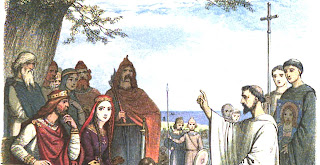 |
| Christian persecution under Emperor Decius |
Novation (also called Novatus) was a 3rd century scholar and theologian during a time when Christians were still being actively persecuted in the Roman Empire, especially during the reign of Emperor Decius (249-251). Decius assassinated Pope Fabian (c.200-250), and executed many Christians unless they chose to renounce their faith and worship the Roman pantheon. The position of pope remained vacant for a year. After the death of Decius in 251, a moderate Roman aristocrat named Cornelius was elected by a majority of local bishops.
Pope Cornelius was willing to forgive the Lapsi, the lapsed Christians who saved their lives by recanting or worshiping in the Roman style. This was unacceptable to Novatian. He got three bishops together in Rome who were willing to see things his way, and they elected him pope.
Both popes sent messengers from Rome to declare their election. Confusion reigned, then investigation. The Church in Africa supported Cornelius, as did (Saint) Dionysius of Alexandria and (Saint) Cyprian. Novatian tried to use his "authority" to create new bishops to replace those in the provinces. It quickly became clear that Corneliuus was favored over Novatian by the majority, making Novatian the second anti-pope.
The roots of his unwillingness to forgive such disloyalty to Christianity did not just come from a stern nature, however; he believed forgiveness by the Church was simply not possible. He held that only God had the power of forgiveness for sins, and that earthly prelates could not pardon the serious sin of idolatry. This was not unprecedented: Tertullian (c.160-225) had criticized pardons for adultery made by Pope Calixtus I (217-222). Ultimately, however, the church decided to allow itself to forgive sins. Novatianism survived a couple centuries after his death in 258, but as a heresy, eventually to be stamped out and replaced with a more forgiving Christianity.
Novatian may no longer have followers, but he has at least one fan, who offers a picture of Novatian's tomb.










